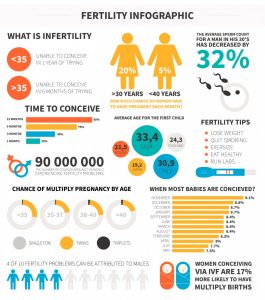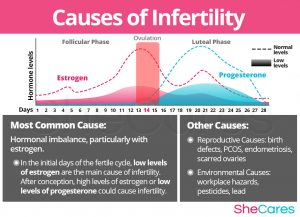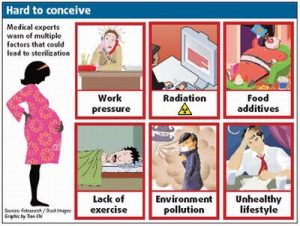
Table of Contents
What is Infertility?
- Infertility is an inability to conceive.
- In many cases, it is also referred to the disease of a reproductive system defined by failure to achieve pregnancy even after 12 months or more of regular sexual intercourse.
- However, we need to understand that both men and women can be infertile.
Global Burden of Infertility:

- In 2004, one in every four couples in developing countries were found to be affected by infertility. This accounts to 48.5 million couples.
- In 2010, approximately 10.5% of women around the world experienced secondary infertility, and roughly 2% experienced primary infertility.
- The infertility rate has not changed between 1982 to 2010
- However, infertility rate seems to have reached peak at present days
What is sub-fertility and secondary infertility?
- On the other hand, sub-fertility generally describes any form of reduced fertility with prolonged time of unwanted non-conception.
- Likewise, secondary infertility refers to inability of having a baby after the women has once already given birth.
- The causes of secondary infertility and general infertility are similar
- Mostly, complications from previous pregnancy and long term of use of contraception is the major reason for infertility.
Causes of infertility in females:
1. Problems in ovulation
- Hormonal imbalance
- Presence of tumor or cyst
- Thyroid gland problem
- Stress
- Excess weight
- Extremely brief menstrual cycle

2. Damage in fallopian tube
- Pelvic inflammatory disease
- Infection of upper female genital tract
- Endometriosis
- Condition where small pieces of womb lining i.e. endometriosis grows at another place
- This damages the fallopian tube and ovaries
- Infection
- Scar or tissue
- Previous ectopic pregnancy
- Birth defect
- Fibroids
- Growth of fibroids around the womb affects fertility
- Can create the unsuitable condition for the attachment of the egg
- Abnormal cervical mucus
- Mucus needs to be thinner so that the sperm can swim through it easily
- Secretion of thick mucus affects the mobility of the sperm
Causes of infertility in men:
1. Problem in semen and sperm
- Low sperm count
- Low sperm mobility
- Abnormal sperm
2. Other factors
- Genetic factors (Klinefelter’s Syndrome)
- Mumps after puberty may cause inflammation of the testicles and affect sperm production
- Hypospadias (a condition when urethral opening is under the penis instead of tip)
- Ejaculation disorder
- Disease like Cushing’s syndrome, diabetes, thyroid disease is also linked with infertility
- Stress
- Excessive weight
Unexplained infertility:
When none of the reasonable reasons are the cause and still the problem of infertility exist then it is termed as unexplained infertility.
30% of the couple seeking the fertility care are affected by unexplained infertility.
Causes for increase in the infertility:
Some of the major causes of infertility are:
1. Life-style
- The life style of individual has greatly changed over the decade. People have become more sedentary and their food habits are unhealthy.
- Smoking, alcohol, overweight, etc.
- Poor nutrition further increases the chance of infertility.

2. Environmental factors
- Studies reveal that due to various environmental factors the sperm count in men has highly reduced over the period of time
- This could be the combined effect of environmental and lifestyle factors.
- The increased in exposure to radiation, chemicals and other environmental factors might be the cause for increase in infertility in both men and women.
3. Age
- Fertility of women is greatly affected by the age.
- The chance of conception is less after the 35 years. However, pregnancy at advanced age is the trend now.
- Couples prioritize education, career more over staring the family
- They usually would like to have children at late 20s or early 30s. It definitely increases infertility, mostly secondary infertility.
Mitigation strategies to reduce infertility:
a) Education
- Education and awareness help in decreasing the burden of the infertility
- Education would further improve the knowledge regarding reproductive health
- It also enables the person to adopt healthy behaviors
b) Abortion services
- Unsafe abortion is the major reason for the secondary infertility.
- Safe abortion services should be made available through private and public sectors
c) Screening
- The married couples should be regularly screened for any reproductive health problems/disorders.
- They can be screened for STI’s
- At the same time, safe sex should also be promoted as much as possible
d) Avoid drugs and alcohol
- Regular and excessive intake of alcohol and drugs is the cause of infertility in both men and women
- Stopping the intake of alcohol and drugs helps to prevent infertility
- Additionally, smoking is also linked with low sperm count. Thus, it should be reduced to decrease the chances of infertility
e) Maintain healthy weight
- Maintaining healthy weight is always crucial for good reproductive health. Eating disorders supports infertility.
- Being overweight or underweight can stop ovulation in females.
- Excessive exercise to stay fit can cause irregular or no menstruation in women and low sperm count in men. Thus, maintaining healthy weight is very essential to reduce the chances of infertility.
References and For More Information:
http://www.who.int/reproductivehealth/topics/infertility/definitions/en/
http://www.feronaivf.com/infertility.html
https://www.ncbi.nlm.nih.gov/pubmed/15802321
http://americanpregnancy.org/infertility/female-infertility/
https://www.medicalnewstoday.com/articles/165748.php
https://www.nhs.uk/conditions/infertility/causes/
http://womhealth.org.au/pregnancy-and-parenting/five-causes-female-infertility (check again)
http://www.who.int/reproductivehealth/topics/infertility/burden/en/
https://journals.plos.org/plosmedicine/article?id=10.1371/journal.pmed.1001356
https://www.bionews.org.uk/page_93930
http://theconversation.com/why-infertility-is-becoming-a-public-health-issue-in-europe-40792
https://academic.oup.com/heapol/article/24/2/108/593016
https://attainfertility.com/understanding-fertility/wellness-and-fertility/preventing-infertility/
https://blog.episona.com/what-is-unexplained-infertility/
https://fertilitysa.com.au/2018/01/11/the-top-3-reasons-fertility-is-on-the-rise/